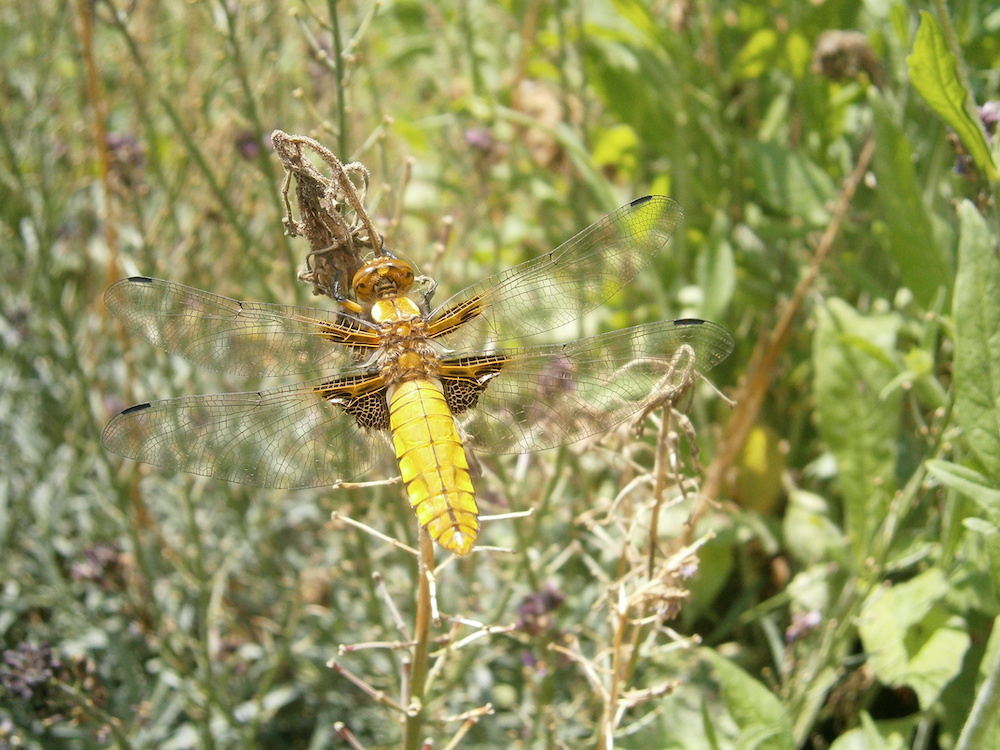Half way through the year now, the summer solstice has passed and the on-off summer lurches on. The days will begin to shorten. Swifts are screaming through the garden as they prepare to leave us. Every year, they fly up at the eaves of the house and perch briefly on the gutters. I assume they are checking out nest sites for next year and will probably be first time breeders at three or four years old. Swifts seem to define our summers but then one morning I realise they haven’t been heard for a few days. They were still here this week but as July moves on so will the swifts.
July’s other great winged visitors are the dragonflies and damselflies. I made a lockdown pond and, although small and still settling into itself, it has been blessed by four different species. The first to arrive was a male Broad Bodied Chaser – known for quickly colonising new ponds. It is very territorial and sits on nearby perches to keep an eye open for rivals, every few minutes doing a quick tour and back to its sunny spot. After a week a female arrived, brown to his blue, and was soon laying eggs into the water. Chasers lay what are known as Exophytic eggs, round eggs that are deposited directly into the water and lie just below the surface.
The next visitor was the Common Blue Damselfly. Tiny little darts of blue hovering around the pond – there were five males on several days. One female arrived and, protected by her successful suitor, laid her eggs. Damselflies lay Endophytic eggs, oval shaped eggs laid directly into plant stems or rotting wood.

Now I have a new pond already expectant with three species of these amazing creatures. Eggs usually hatch within a few weeks but it will be 2-3 years before the life cycle completes and the larvae emerge to become the dragonflies that grace our summer. Just before dawn on a warm July day the nymphs will emerge from the pond and around12 hours later the adults take to the wing. With fossil dragonflies being found from over 300 million years ago this is a story that keeps unfolding.
Damselflies are smaller and at rest close their wings whereas the larger dragonflies rest with their wings open. Damselflies have more of a fluttering flight, seeming delicate and more fluid in character. The more robust dragonfly can be an aggressive predator and its stiff wings can be heard as it comes up to inspect you or rushes down a green lane looking for insects. Masters of aerobatics they can move each wing independently allowing them to hover, fly backwards and turn sharply. They can also fly at speeds of up to 30mph.
There are 57 species recorded in the UK but only a dozen are more commonly seen. They are rich in imagery and name. Darters, chasers and hawkers describe the main groups of dragonflies and their colours are jewels: emerald, azure, sapphire and ruby. Imagine the rippled reflections of sunlight on water and you will see the glory of these winged insects as they sparkle across a wetland.
I have a fancy for a dual life
so I can taste the water
and the air. I’d like to try
being ugly, overlooked
and where I can hang out
with fish and frogs and feel
caress of ripples, share
the bubbled oxygen that
diving beetles bring,
and the sun clear through
a skin of water. But then –
oh joy – to creep up some
tall stem of reed, clasp to it
under summer sun, to shed
the damp and blackened me
and there, plant slung,
unfold a mirror to the sky,
pump up my wings,
shiver out of water
– and to fly.
